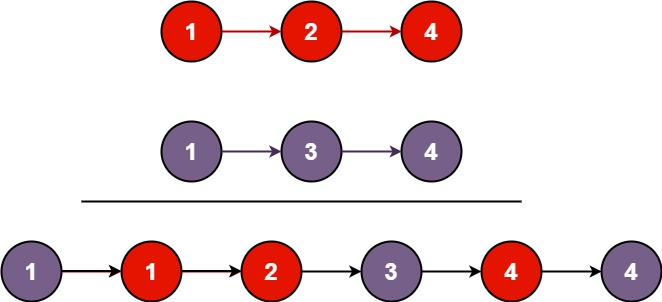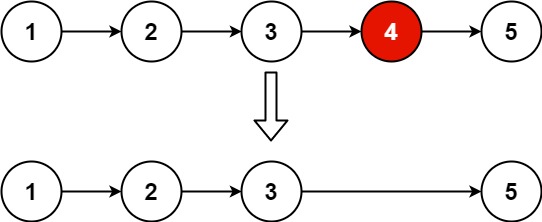📅Day-14 Striver’s SDE Sheet | Linked List Part 1 | Merge two sorted Linked Lists , Remove N-th node from the end of a Linked List.
 Payal Kumari
Payal Kumari
Note : Started my 27-day DSA journey with Striver’s SDE Sheet!
I will be journaling every day — recording what I learn, reflecting on it, and sharing it with my network to help fellow learners and aspiring developers.. Learning through videos, resources, and the internet — simplifying logic in my own way with real-world connections. Sharing 2 questions daily: brute-force to optimal, clean Java code, time & space complexity, and key patterns.
This blog series is for anyone preparing for coding interviews — whether you’re a beginner or a revision warrior. Let’s grow together! 🚀
Namaste Developers! 🙏
Welcome to Day 14 of my 27-day DSA journey using Striver’s SDE Sheet!
1️⃣ Merge two sorted Linked Lists
🔸 Problem Statement:
You are given the heads of two sorted linked lists list1 and list2.
Merge the two lists into one sorted list. The list should be made by splicing together the nodes of the first two lists.
Return the head of the merged linked list.
Example 1:

Input: list1 = [1,2,4], list2 = [1,3,4]
Output: [1,1,2,3,4,4]
Example 2:
Input: list1 = [], list2 = []
Output: []
Example 3:
Input: list1 = [], list2 = [0]
Output: [0]
Constraints:
The number of nodes in both lists is in the range
[0, 50].-100 <= Node.val <= 100Both
list1andlist2are sorted in non-decreasing order.
💠Real-Life Example
Imagine you have two queues of students standing in increasing order of their height:
Queue A → [150cm, 160cm, 170cm]
Queue B → [155cm, 165cm, 175cm]
Now, the teacher says — "Merge both queues into one big queue but still maintain height order".
So you start comparing the first students in both queues and pick the shorter one first to stand in the merged queue. Repeat until one queue is empty, and then append the rest.
This is exactly how merging works in Linked Lists.
(Hinglish : Socho tumhare paas do queues hain students ki, jo apni height ke increasing order mein khade hain:
Queue A → [150cm, 160cm, 170cm]
Queue B → [155cm, 165cm, 175cm]
Ab teacher bolti hain — "Dono queues ko ek badi queue mein merge karo, lekin height ka order same rehna chahiye."
Toh tum dono queues ke first students ko compare karoge, jo chhota hoga usko pehle merged queue mein rakhoge. Yeh process repeat karte rahoge jab tak ek queue khali na ho jaye. Phir bachi hui queue ke saare students ko end mein add kar doge.
Bilkul yeh hi process Linked Lists merge karte time hota hai.)
💠Brute Force Approach
📍Idea:
Extract all elements from both linked lists into a new array/list.
Sort that array.
Build a new linked list from it.
📍Steps:
Traverse list1 and store values in an array.
Traverse list2 and store values in the same array.
Sort the array.
Create a new linked list from this sorted array.
class Solution {
public ListNode mergeTwoLists(ListNode list1, ListNode list2) {
List<Integer> arr = new ArrayList<>();
// Store elements of list1
while (list1 != null) {
arr.add(list1.val);
list1 = list1.next;
}
// Store elements of list2
while (list2 != null) {
arr.add(list2.val);
list2 = list2.next;
}
// Sort the array
Collections.sort(arr);
// Build new linked list
ListNode dummy = new ListNode(-1);
ListNode temp = dummy;
for (int val : arr) {
temp.next = new ListNode(val);
temp = temp.next;
}
return dummy.next;
}
}
📍Time Complexity:
O((n+m) log(n+m)) → because of sorting.
📍Space Complexity:
O(n+m) → extra space for storing elements.
( Hinglish Note:
Yeh approach simple hai lekin zyada space & sorting time lagta hai. Interview me pass ho jayega but not optimal.)
💠 Optimal Approach (Two Pointer Technique)
📍Idea:
Since both linked lists are already sorted, we can merge them like in Merge Sort using two pointers without sorting again.
📍Steps:
Create a dummy node to simplify list creation.
Keep two pointers
p1andp2at heads oflist1andlist2.Compare values at
p1andp2.- Pick the smaller node and move that pointer ahead.
Repeat until one list becomes empty.
Append the remaining list to the merged list.
class Solution {
public ListNode mergeTwoLists(ListNode list1, ListNode list2) {
ListNode dummy = new ListNode(-1);
ListNode tail = dummy;
while (list1 != null && list2 != null) {
if (list1.val <= list2.val) {
tail.next = list1;
list1 = list1.next;
} else {
tail.next = list2;
list2 = list2.next;
}
tail = tail.next;
}
// Attach the remaining nodes
if (list1 != null) tail.next = list1;
if (list2 != null) tail.next = list2;
return dummy.next;
}
}
📍Time Complexity
- O(n + m) → We visit each node exactly once.
📍Space Complexity
- O(1) → No extra array, only pointers.
(Hinglish Note:
Yeh approach fatafat kaam karta hai, bilkul efficient hai, aur interviews me thumbs up milega.)
💠Key Takeaways
Brute Force: Simple but not efficient (O((n+m) log(n+m)) time).
Optimal: Two-pointer merge in O(n+m) time and O(1) space.
Tip: Dummy node use karna life easy bana deta hai.
✅ Final Advice for Beginners:
Pehle Brute Force samajho, phir Optimal.
Real-life analogy yaad rakho — "Do sorted queues ko ek me merge karna".
Linked list problems me pointer manipulation ka game strong karo.
2️⃣ Remove Nth Node From End of List
🔸 Problem Statement:
Given the head of a linked list, remove the n<sup>th</sup> node from the end of the list and return its head.
Example 1:

Input: head = [1,2,3,4,5], n = 2
Output: [1,2,3,5]
Example 2:
Input: head = [1], n = 1
Output: []
Example 3:
Input: head = [1,2], n = 1
Output: [1]
Constraints:
The number of nodes in the list is
sz.1 <= sz <= 300 <= Node.val <= 1001 <= n <= sz
Follow up: Could you do this in one pass?
💠Real-Life Example
Imagine a train with bogies numbered from front to back.
The problem is: "Remove the nth bogie from the end."
Example: Train bogies → 1 - 2 - 3 - 4 - 5
If n = 2, then from the end, bogie 4 will be removed.
💠Brute Force Approach (2 Pass Method)
🔍 Idea
First pass: Count total number of nodes
len.Second pass: Remove
(len - n + 1)th node from the front.
class Solution {
public ListNode removeNthFromEnd(ListNode head, int n) {
int length = 0;
ListNode temp = head;
// 1st pass: find length
while (temp != null) {
length++;
temp = temp.next;
}
// If head node is to be removed
if (length == n) return head.next;
// 2nd pass: go to (length - n)th node
temp = head;
for (int i = 1; i < length - n; i++) {
temp = temp.next;
}
temp.next = temp.next.next;
return head;
}
}
✅ Complexity
Time Complexity (TC):
O(2N)≈O(N)→ We traverse the list twice.Space Complexity (SC):
O(1)→ No extra space used.
💠Optimal Approach (One Pass – Two Pointer Technique)
📍Idea
Use two pointers
fastandslow.Move
fastpointernsteps ahead.Move both
fast&slowuntilfastreaches the end.slow.nextwill be the node to remove.
class Solution {
public ListNode removeNthFromEnd(ListNode head, int n) {
ListNode dummy = new ListNode(0);
dummy.next = head;
ListNode fast = dummy;
ListNode slow = dummy;
// Move fast ahead by n+1 steps
for (int i = 0; i <= n; i++) {
fast = fast.next;
}
// Move both fast and slow together
while (fast != null) {
fast = fast.next;
slow = slow.next;
}
// Remove target node
slow.next = slow.next.next;
return dummy.next;
}
}
✅ Complexity
Time Complexity (TC):
O(N)→ Only one pass.Space Complexity (SC):
O(1)→ Constant extra space.
(Hinglish :
Brute Force mein hum pehle list ka length nikalte hain aur phir
(length - n)th node se aage wale ko remove kar dete hain.Optimal mein hum ek baar hi traverse karte hain using Two Pointer Technique → fast ko pehle n steps aage bhej dete hain, phir fast & slow ko ek saath chala dete hain jab tak fast end tak nahi pahunchta, aur slow ke next ko remove kar dete hain.)
📍Key Takeaways
(Hinglish:
Linked List ke problems ka best friend = Two Pointer Technique 😎
Brute Force → Easy but 2 passes.
Optimal → Same TC but ek hi pass mein kaam.)
📍Real Coder (Hinglish Tip: Jab interview mein yeh question aaye, pehle brute force explain karo (easy samajhne ke liye) and phir optimal likho – interviewer ko lagega tum systematic approach follow karte ho.)
✍️ Final Notes:
If you're just starting your DSA journey like me, don't worry if you don’t get it perfect the first time.
Visualize → Dry Run → Optimize.
Stay consistent, and let’s crack every problem from brute to optimal! 💪
🙏 Special Thanks
A heartfelt thank you to Rajvikraaditya Sir for creating and sharing such an incredible DSA resource with the community (takeuforward). Your structured approach has made DSA more accessible and less intimidating for thousands of learners like me.
If this helped you, do share it with your fellow DSA learners.
Comment with your doubts — I’d love to answer and grow together 🌱
✍️ Payal Kumari 👩💻
My 27-Day DSA Journey with Striver’s Sheet! #dsawithpayal

Subscribe to my newsletter
Read articles from Payal Kumari directly inside your inbox. Subscribe to the newsletter, and don't miss out.
Written by

Payal Kumari
Payal Kumari
I'm a passionate full-stack developer with a strong foundation in the MERN stack—building and maintaining scalable web applications using React.js, Node.js, and Next.js. My journey in open source began with Hacktoberfest 2023, where I made four impactful pull requests that sparked a love for collaborative coding, global learning, and open knowledge sharing. Since then, I’ve contributed to and mentored projects in top open source programs like GSSoC’24, SSOC’24, and C4GT’24. As a Google Gen AI Exchange Hackathon ’24 Finalist and Google’s Women Techmakers (WTM) Ambassador, I’ve been privileged to support diverse communities in building meaningful tech solutions. My work as a Top 50 Mentor for GSSoC ’24 reflects my commitment to nurturing new talent in tech. Beyond development, I serve as a Student Career Guide, Profile Building Expert & Evangelist at Topmate.io, where I conduct workshops, guide students through resume building and career strategy, and help mentees navigate open source and tech careers. Recognized among the Top 5% of mentors and featured on “Topmate Discover,” I take pride in making mentorship accessible and impactful. My technical voice has also been acknowledged by LinkedIn, where I’ve earned the Top Voice badge seven times in domains like web development, programming, and software engineering. In addition, I hold LinkedIn Golden Badges for Research Skills, Interpersonal Skills, Critical Thinking, and Teamwork—signaling a well-rounded approach to both individual contribution and team collaboration. Graduating with an MCA from Chandigarh University in 2023, I’ve continued to fuel my curiosity by writing technical articles and sharing practical MERN stack insights across platforms. Whether it’s building polished UIs, optimizing backend performance, or guiding a mentee through their first pull request, I’m driven by the power of community and continuous learning. Let’s connect! I'm open to collaborations, mentorship, or building something impactful together. Reach out to me at kumaripayal7488@gmail.com or visit my profile on Topmate.io.